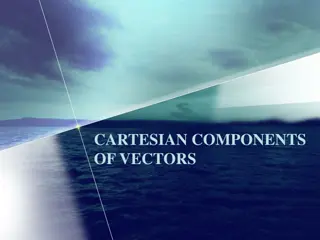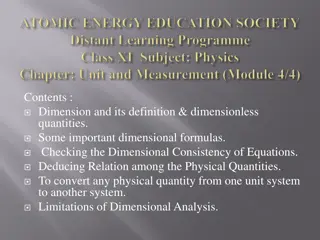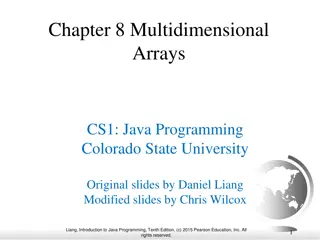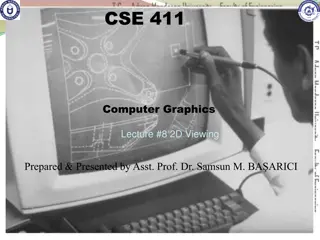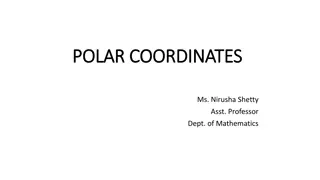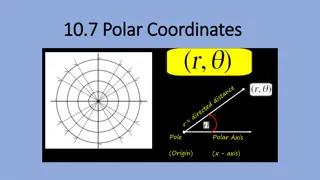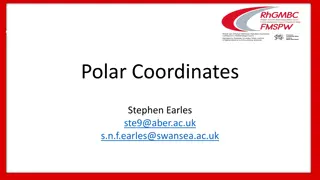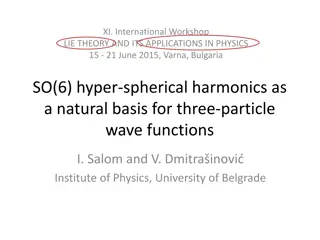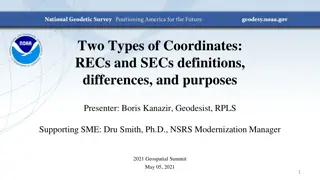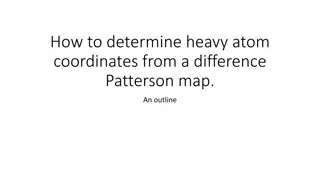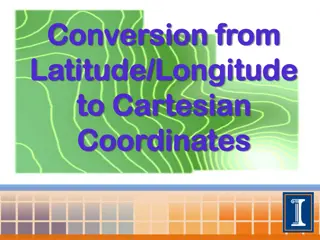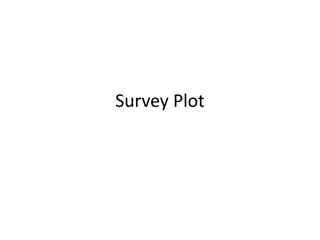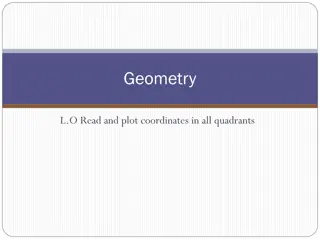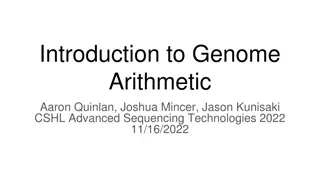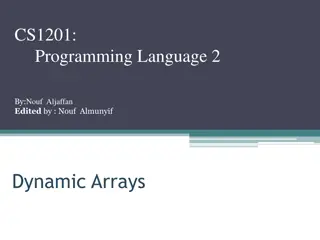Interactive Pirate Treasure Hunt with Coordinates and Directions
Explore the exciting world of pirate treasure hunting using coordinates, angles, and directions on a map. Learn how to locate hidden treasures by following clues and instructions. Try your hand at finding the treasure using different methods such as reading coordinates, moving in vectors, and naviga
2 views • 5 slides
Introduction to Cartesian Components of Vectors in Two-Dimensional Space
Exploring Cartesian components of vectors in a two-dimensional coordinate frame using unit vectors i and j. Learn how to express vectors, add them using the triangle law, use column vector notation, and find resultant vectors. Understand position vectors in terms of coordinates. Examples and diagram
2 views • 16 slides
Dimensional Analysis in Physics
Dimensional analysis in physics involves defining dimensions of physical quantities, determining dimensionless quantities, checking dimensional consistency of equations, converting units, and exploring the limitations and applications of dimensional analysis. By understanding dimensions and dimensio
1 views • 14 slides
Two-Dimensional Arrays in Java Programming
Explore the concept of two-dimensional arrays in Java programming through examples and illustrations. Learn how to declare, create, and initialize two-dimensional arrays efficiently to represent matrices or tables. Discover the benefits of using multi-dimensional arrays for data organization and man
2 views • 25 slides
2D Viewing in Computer Graphics
Exploring the concept of 2D viewing in computer graphics, this lecture covers the 2D viewing pipeline, including clipping, window normalization, viewport transformations, and OpenGL 2D viewing functions. It explains how a picture is defined using a Cartesian coordinate system, selecting views within
7 views • 84 slides
Comprehensive Overview of Freezing Time Methods in Dairy Engineering
Neumann, Tao, and Non-Dimensional methods are key approaches for determining freezing times in unsteady state heat transfer processes in dairy engineering. The Neumann Problem, Tao Solutions, and Cleland and Earle Non-Dimensional Equation offer distinct equations and models to calculate freezing tim
4 views • 8 slides
Polar Coordinates in Mathematics
Polar coordinates define the location of a point in terms of distance and angle from an origin. The distance is denoted by "r" and the angle by "?". However, the angle is not unique for a point. The concept involves fixing an origin and an initial ray, with positive angles measured counterclockwise.
3 views • 7 slides
Polar Coordinates in Mathematics
Polar coordinates provide an alternative way to plot points using a directed angle and distance from the origin. This system involves radius (distance) and angle measurements, allowing for multiple representations of points. Graphing polar coordinates, converting between polar and rectangular coordi
1 views • 19 slides
Introduction to Polar Coordinates: A Different Coordinate System
Exploring the concept of polar coordinates, a coordinate system introduced in the mid-seventeenth century by notable mathematicians independently. Learn about measuring angles in radians, converting between degrees and radians, and drawing graphs in polar coordinates by considering length and angle
4 views • 34 slides
Exploring Vortex Dynamics in Solar Chromosphere and Two-Dimensional Turbulence
Detailed exploration of various vortex dynamics including MHD Rankine vortex, Rankine vortex in general hydrodynamic, stable 2-dimensional vortex, Burgers-Rott vortex, and MHD equations in cylindrical coordinates. Provides insights into exact solutions, properties, and energy distribution of differe
3 views • 15 slides
Applications of Hyper-Spherical Harmonics in Physics
Explore the utility of hyper-spherical harmonics as a natural basis for solving three-particle wave functions in physics, specifically in areas such as atomic physics, molecular physics, and systems involving three quarks. Learn about their role in reducing the complexity of problems, providing mani
2 views • 28 slides
Fast High-Dimensional Filtering and Inference in Fully-Connected CRF
This work discusses fast high-dimensional filtering techniques in Fully-Connected Conditional Random Fields (CRF) through methods like Gaussian filtering, bilateral filtering, and the use of permutohedral lattice. It explores efficient inference in CRFs with Gaussian edge potentials and accelerated
3 views • 25 slides
REC and SEC Coordinates in Geodesy
Geodesist Boris Kanazir and NSRS Modernization Manager Dru Smith delve into the definitions, differences, and purposes of Reference Epoch Coordinates (RECs) and Survey Epoch Coordinates (SECs) at the 2021 Geospatial Summit. OPUS coordinates, SEC computation by NGS every four weeks, REC re-computatio
5 views • 17 slides
Deciphering Heavy Atom Coordinates from Difference Patterson Map: An Overview
Understanding how to determine heavy atom coordinates from a difference Patterson map involves recognizing the relationship between Patterson peak coordinates (u,v,w) and space group symmetry operators in crystallography. By solving equations that relate these coordinates, the absolute positions of
5 views • 5 slides
Geodetic Datums and WGS-84 Coordinates
Geodetic datums define the earth's shape and size, serving as reference points on coordinate systems. Vertical datums establish zero surface elevation, while horizontal datums form the basis for horizontal coordinates. The World Geodetic System 1984 (WGS-84) is the reference system used by GPS and l
4 views • 29 slides
Shoe Lace Method for Finding Polygon Areas
The Shoe Lace Method is a mathematical process used to determine the area of any polygon by employing coordinate geometry. By following specific steps, including organizing coordinates, multiplying diagonally, and adding columns in a certain manner, the method allows for a straightforward calculatio
11 views • 8 slides
Graphics Output Primitives and Coordinate Reference Frames
Graphics output primitives and coordinate reference frames play a crucial role in describing scenes and drawing basic geometric structures in 2D space. These concepts involve defining points, drawing lines, and understanding pixel coordinates within a coordinate system. Absolute and relative coordin
7 views • 35 slides
Weak Superconductivity and Functional Coordinates
Delve into the realm of weak superconductivity and the significance of functional coordinates in this informative presentation. Explore the intricacies of these concepts through a series of visually appealing slides that shed light on their characteristics and applications. Gain insights into the re
1 views • 8 slides
Calculating Polygon Area and Trapezium Area with Known Coordinates
The content above guides you on finding the exact area of a polygon by calculating the areas of individual triangles within it. It also demonstrates how to list coordinates in a spreadsheet, calculate the area of trapeziums formed by pairs of coordinates, and sum their areas to determine the total a
4 views • 28 slides
Three-dimensional & Advanced Interaction
This seminar explores topics related to three-dimensional interaction, augmented reality, and advanced interaction techniques. The sessions cover various aspects such as markerless tracking, augmented reality gaming, 3D perception, input devices, output devices, and navigation in virtual environment
4 views • 10 slides
High-Dimensional Neighbor Search: Applications in Machine Learning
Explore the realm of high-dimensional neighbor search techniques, featuring applications in machine learning such as the nearest neighbor rule and near-duplicate retrieval. Understand concepts like Voronoi diagrams, approximate nearest neighbor algorithms, and more. Delve into the complexities and e
5 views • 30 slides
Coordinates in Geometry
Coordinates in geometry are used to represent specific positions on a coordinate plane. This involves assigning an order to points in all quadrants, understanding the x-axis and y-axis, plotting points accurately, and determining the coordinates of various shapes. By learning to read and plot coordi
2 views • 13 slides
Geometry Focus: Reflections, Translations & Coordinates in Year 5
Explore the concepts of reflections, translations, and coordinates in geometry with a focus on shapes in the first quadrant. Learn how to identify, describe, and represent shape positions following transformations. Key vocabulary like reflection, translation, and coordinates will be covered. Enhance
4 views • 33 slides
Introduction to Genome Arithmetic and Coordinates
In this presentation, delve into the realm of genome arithmetic and coordinates through insightful discussions on reference genomes, functional consequences of variants, and designing sequencing panels. Explore the significance of genome coordinates in identifying specific locations within a referen
2 views • 25 slides
Analysis of Determinate Structures in Engineering Mechanics
Structural analysis in engineering mechanics involves treating structures as rigid bodies, analyzing internal forces like axial forces, shearing forces, and bending moments. Strength of materials explores material behaviors under different internal forces, while structural forms include one-dimensio
0 views • 12 slides
Dynamic Arrays and Two-Dimensional Arrays in C++ Programming
Explore dynamic arrays and two-dimensional arrays in C++ programming, covering concepts such as array size, pointers, array initialization, and dynamic memory allocation. Learn how to create dynamic two-dimensional arrays and effectively manage memory allocation for multi-dimensional arrays in C++.
2 views • 13 slides
Introduction to Data Engineering and Dimensional Modeling Techniques
This content provides insights into data engineering and dimensional modeling techniques like Kimball Dimensional Modeling. It covers gathering business requirements, dimensional design processes, creating fact tables, working with facts and dimensions, and extending dimensional models. Learn about
1 views • 12 slides
Polar Coordinates and Conversions
Explore the concept of polar coordinates, multiple representations, negative r values, and conversion between rectangular and polar coordinates. Learn how to determine which point does not represent the same coordinates as others in a given set.
3 views • 53 slides
Coordinate Geometry: Naming Vertices, Using Variables
Explore coordinate geometry concepts by naming vertices of figures and using variables for coordinates. Understand how to identify and work with coordinates efficiently. Dive into Problem 1 to name vertices and Problem 2 to use variable coordinates effectively in various figures.
2 views • 6 slides
Cylindrical Coordinates in Advanced Mathematics
Explore the concept of cylindrical coordinates, a three-dimensional coordinate system used to specify a point's location based on radial distance, azimuthal angle, and height. Learn about conversions between cylindrical and Cartesian coordinates, along with practical applications in various fields l
1 views • 20 slides
Directional Derivatives and Gradient Vectors in Advanced Mathematics
Explore directional derivatives, gradient vectors, and examples on cylindrical coordinates in advanced mathematics under the guidance of Dr. Mazin R. Khalil. Dive into the conversion of cylindrical coordinates to rectangular coordinates and enhance your understanding of mathematical concepts.
2 views • 30 slides
Coordinates and Equations in Graphs
Explore the concept of coordinates and equations on a graph through various examples such as finding coordinates on a line, plotting points based on equations, and interpreting the relationships between x and y coordinates. Practice and enhance your graphing skills with interactive visuals.
2 views • 34 slides
Data Warehousing Dimensional Modeling Essentials
This article delves into dimensional modeling, a crucial aspect of data warehousing. Understand the process of designing and implementing dimensional models in relational databases. Explore concepts such as Kimball Lifecycle, requirements analysis, terminology translation, and enterprise bus matrix
0 views • 45 slides
Generalized Coordinates and Degree of Freedom in Physics
Explore the concept of generalized coordinates and degree of freedom in physics, understanding how holonomic constraints affect the number of independent coordinates needed to describe a system. Learn about the degrees of freedom for systems like a simple pendulum and particles moving on a sphere, a
0 views • 12 slides
Using Table Mode for Function Coordinates
Learn how to find the coordinates of a function by using the table mode feature. Explore graphing functions, changing calculator modes, and step-by-step processes to determine coordinates within a specified domain. Enhance your understanding of function analysis and graph plotting with practical exa
0 views • 7 slides
Understanding Perceptual Mapping in Marketing
Perceptual mapping is a diagrammatic technique used by marketers to visually represent customer perceptions. This technique helps businesses understand how customers view their brand, product, or service, influencing brand positioning. Perceptual maps can be two-dimensional or multi-dimensional, pro
1 views • 12 slides
Uncover Pirate Treasures with Halloween-themed Map Challenges
Embark on a Halloween treasure hunt using coordinates, angles, and directions to locate pirate treasure on a map. Learn to read positions, follow vector coordinates, and use polar coordinates to find hidden gems. Enjoy the adventure with engaging worksheets included.
0 views • 5 slides
Understanding REC and SEC Coordinates in Geodesy
Explore the differences and purposes of Reference Epoch Coordinates (RECs) and Survey Epoch Coordinates (SECs) in geodesy, covering how they are computed, updated, and used by NGS. Learn how OPUS coordinates tie into the NSRS, the time dependency of SECs, and the re-computation cycle of RECs.
0 views • 17 slides
Complex Numbers in Digital Signal Processing - Understanding Polar Coordinates
Learn about complex numbers and polar coordinates in the context of digital signal processing. Discover how to convert between Cartesian and polar coordinates using MATLAB functions for efficient signal processing applications.
0 views • 5 slides
Rectangle Properties and Transformations Explained
Explore the concept of rectangles through identifying missing coordinates, calculating perimeter, and investigating translations. Challenge yourself to draw rectangles with the same dimensions in different locations and understand the changes in coordinates through translations. Engage in discussion
2 views • 23 slides

